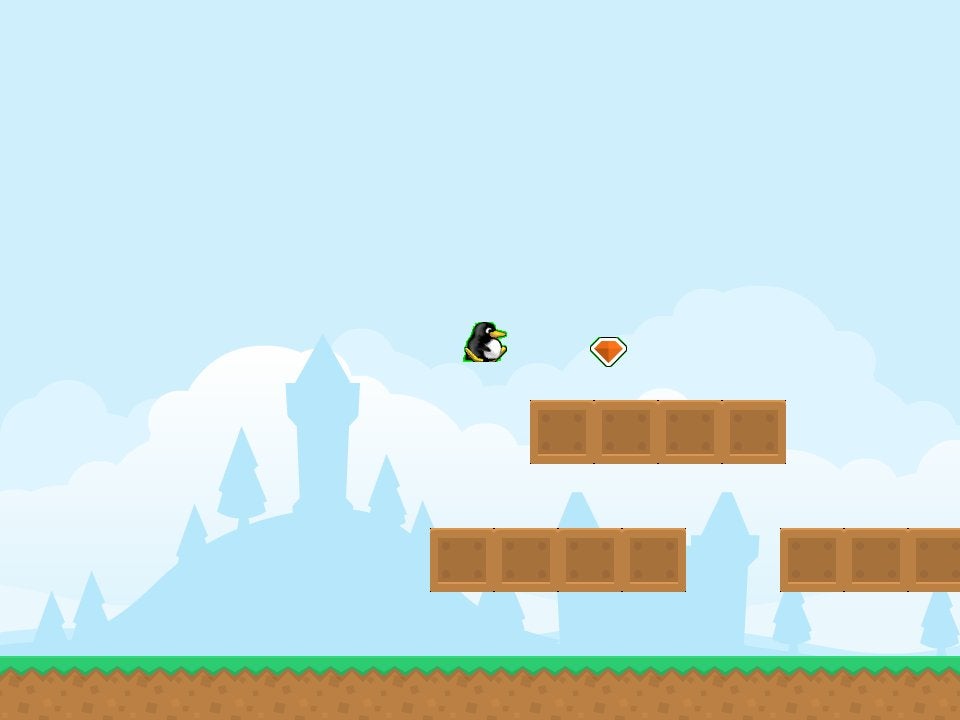This is part of an ongoing series about creating video games in Python 3 using the Pygame module. Previous articles are:
- Learn how to program in Python by building a simple dice game
- Build a game framework with Python using the Pygame module
- How to add a player to your Python game
- Using Pygame to move your game character around
- What's a hero without a villain? How to add one to your Python game
- Put platforms in your Python platformer
- Simulate gravity in your Python game
- Add jumping to your Python platformer game
- Enable your Python game player to run forward and backward
If you've followed along with the previous articles in this series, then you know all the basics of programming video game mechanics. You can build upon these basics to create a fully functional video game all your own. Following a "recipe" like the code samples in this series is helpful when you're first learning, but eventually, the recipe becomes a constraint. It's time to use the principles you've learned and apply them in new ways.
If that sounds easier said than done, this article demonstrates an example of how to leverage what you already know for new purposes. Specifically, it covers how to implement a looting system
using what you have already learned about platforms from previous lessons.
In most video games, you have the opportunity to "loot," or collect treasures and other items within the game world. Loot usually increases your score or your health or provides information leading to your next quest.
Including loot in your game is similar to programming platforms. Like platforms, loot has no user controls, scrolls with the game world, and must check for collisions with the player sprite.
Before you begin, you must have a loot graphic, such as a coin or a treasure chest. If you've already downloaded my recommended tile set, the simplified-platformer-pack from Kenney.nl, then you can use a diamond or key from that.
Creating the loot function
Loot is so similar to platforms that you don't even need a Loot class. You can just reuse the Platform class and call the results loot.
Since loot type and placement probably differ from level to level, create a new function called loot in your Level class, if you don't already have one. Since loot items are not platforms, you must also create a new loot_list group and then add loot objects to it. As with platforms, ground, and enemies, this group is used when checking for collisions:
def loot(lvl):
if lvl == 1:
loot_list = pygame.sprite.Group()
loot = Platform(tx*9, ty*5, tx, ty, 'loot_1.png')
loot_list.add(loot)
if lvl == 2:
print(lvl)
return loot_listIn this code, I express the location of the loot as multiples of the tile size: tx on the X axis and ty for the Y axis. I do this because i mapped my level on graph paper, so it's easy to just count the squares on my map and then multiply it by the tile size, rather than calculating the pixel count. This is especially true for very long levels. You can hard code the pixel count, if you prefer.
You can add as many loot objects as you like; just remember to add each one to your loot list. The arguments for the Platform class are the X position, the Y position, the width and height of the loot sprite (it's usually easiest to keep your loot sprite the same size as all other tiles), and the image you want to use as loot. Placement of loot can be just as complex as mapping platforms, so use the level design document you created when creating the level.
Call your new loot function in the Setup section of your script. In the following code, the first three lines are for context, so just add the fourth:
loot_list = Level.loot(1)As you know by now, the loot won't get drawn to the screen unless you include it in your main loop. Add this line to your loop:
loot_list.draw(world)Launch your game to see what happens.

Your loot objects are spawned, but they don't do anything when your player runs into them, nor do they scroll when your player runs past them. Fix these issues next.
Scrolling loot
Like platforms, loot has to scroll when the player moves through the game world. The logic is identical to platform scrolling. To scroll the loot forward, add the last two lines:
for e in enemy_list:
e.rect.x -= scroll
for l in loot_list: # loot scroll
l.rect.x -= scroll # loot scrollTo scroll it backward, add the last two lines:
for e in enemy_list:
e.rect.x += scroll
for l in loot_list: # loot scroll
l.rect.x += scroll # loot scrollLaunch your game again to see that your loot objects now act like they're in the game world instead of just painted on top of it.
Detecting collisions
As with platforms and enemies, you can check for collisions between loot and your player. The logic is the same as other collisions, except that a hit doesn't (necessarily) affect gravity or health. Instead, a hit causes the loot to disappear and increment the player's score.
When your player touches a loot object, you can remove that object from the loot_list. This means that when your main loop redraws all loot items in loot_list, it won't redraw that particular object, so it will look like the player has grabbed the loot.
Add the following code above the platform collision detection in the update function of your Player class (the last line is just for context):
loot_hit_list = pygame.sprite.spritecollide(self, loot_list, False)
for loot in loot_hit_list:
loot_list.remove(loot)
self.score += 1
print(self.score)
plat_hit_list = pygame.sprite.spritecollide(self, plat_list, False)Not only do you remove the loot object from its group when a collision happens, but you also award your player a bump in score. You haven't created a score variable yet, so add that to your player's properties, created in the __init__ function of the Player class. In the following code, the first two lines are for context, so just add the score variable:
self.frame = 0
self.health = 10
self.score = 0Applying what you know
As you can see, you've got all the basics. All you have to do now is use what you know in new ways. For instance, if you haven't already placed your enemies in a sensible place, take some time to do that now using the same method you've used to place platforms and loot.
There are a few more tips in the next article, but in the meantime, use what you've learned to make a few simple, single-level games. Limiting the scope of what you are trying to create is important so that you don't overwhelm yourself. It also makes it easier to end up with a finished product that looks and feels finished.
Here's all the code you've written for this Python platformer so far:
#!/usr/bin/env python3
# by Seth Kenlon
# GPLv3
# This program is free software: you can redistribute it and/or
# modify it under the terms of the GNU General Public License as
# published by the Free Software Foundation, either version 3 of the
# License, or (at your option) any later version.
#
# This program is distributed in the hope that it will be useful, but
# WITHOUT ANY WARRANTY; without even the implied warranty of
# MERCHANTABILITY or FITNESS FOR A PARTICULAR PURPOSE. See the GNU
# General Public License for more details.
#
# You should have received a copy of the GNU General Public License
# along with this program. If not, see <http://www.gnu.org/licenses/>.
import pygame
import sys
import os
'''
Variables
'''
worldx = 960
worldy = 720
fps = 40
ani = 4
world = pygame.display.set_mode([worldx, worldy])
forwardx = 600
backwardx = 120
BLUE = (25, 25, 200)
BLACK = (23, 23, 23)
WHITE = (254, 254, 254)
ALPHA = (0, 255, 0)
'''
Objects
'''
# x location, y location, img width, img height, img file
class Platform(pygame.sprite.Sprite):
def __init__(self, xloc, yloc, imgw, imgh, img):
pygame.sprite.Sprite.__init__(self)
self.image = pygame.image.load(os.path.join('images', img)).convert()
self.image.convert_alpha()
self.image.set_colorkey(ALPHA)
self.rect = self.image.get_rect()
self.rect.y = yloc
self.rect.x = xloc
class Player(pygame.sprite.Sprite):
"""
Spawn a player
"""
def __init__(self):
pygame.sprite.Sprite.__init__(self)
self.movex = 0
self.movey = 0
self.frame = 0
self.health = 10
self.score = 0
self.is_jumping = True
self.is_falling = True
self.images = []
for i in range(1, 5):
img = pygame.image.load(os.path.join('images', 'hero' + str(i) + '.png')).convert()
img.convert_alpha()
img.set_colorkey(ALPHA)
self.images.append(img)
self.image = self.images[0]
self.rect = self.image.get_rect()
def gravity(self):
if self.is_jumping:
self.movey += 3.2
def control(self, x, y):
"""
control player movement
"""
self.movex += x
def jump(self):
if self.is_jumping is False:
self.is_falling = False
self.is_jumping = True
def update(self):
"""
Update sprite position
"""
# moving left
if self.movex < 0:
self.is_jumping = True
self.frame += 1
if self.frame > 3 * ani:
self.frame = 0
self.image = pygame.transform.flip(self.images[self.frame // ani], True, False)
# moving right
if self.movex > 0:
self.is_jumping = True
self.frame += 1
if self.frame > 3 * ani:
self.frame = 0
self.image = self.images[self.frame // ani]
# collisions
enemy_hit_list = pygame.sprite.spritecollide(self, enemy_list, False)
for enemy in enemy_hit_list:
self.health -= 1
# print(self.health)
ground_hit_list = pygame.sprite.spritecollide(self, ground_list, False)
for g in ground_hit_list:
self.movey = 0
self.rect.bottom = g.rect.top
self.is_jumping = False # stop jumping
# fall off the world
if self.rect.y > worldy:
self.health -=1
print(self.health)
self.rect.x = tx
self.rect.y = ty
plat_hit_list = pygame.sprite.spritecollide(self, plat_list, False)
for p in plat_hit_list:
self.is_jumping = False # stop jumping
self.movey = 0
if self.rect.bottom <= p.rect.bottom:
self.rect.bottom = p.rect.top
else:
self.movey += 3.2
if self.is_jumping and self.is_falling is False:
self.is_falling = True
self.movey -= 33 # how high to jump
loot_hit_list = pygame.sprite.spritecollide(self, loot_list, False)
for loot in loot_hit_list:
loot_list.remove(loot)
self.score += 1
print(self.score)
plat_hit_list = pygame.sprite.spritecollide(self, plat_list, False)
self.rect.x += self.movex
self.rect.y += self.movey
class Enemy(pygame.sprite.Sprite):
"""
Spawn an enemy
"""
def __init__(self, x, y, img):
pygame.sprite.Sprite.__init__(self)
self.image = pygame.image.load(os.path.join('images', img))
self.image.convert_alpha()
self.image.set_colorkey(ALPHA)
self.rect = self.image.get_rect()
self.rect.x = x
self.rect.y = y
self.counter = 0
def move(self):
"""
enemy movement
"""
distance = 80
speed = 8
if self.counter >= 0 and self.counter <= distance:
self.rect.x += speed
elif self.counter >= distance and self.counter <= distance * 2:
self.rect.x -= speed
else:
self.counter = 0
self.counter += 1
class Level:
def ground(lvl, gloc, tx, ty):
ground_list = pygame.sprite.Group()
i = 0
if lvl == 1:
while i < len(gloc):
ground = Platform(gloc[i], worldy - ty, tx, ty, 'tile-ground.png')
ground_list.add(ground)
i = i + 1
if lvl == 2:
print("Level " + str(lvl))
return ground_list
def bad(lvl, eloc):
if lvl == 1:
enemy = Enemy(eloc[0], eloc[1], 'enemy.png')
enemy_list = pygame.sprite.Group()
enemy_list.add(enemy)
if lvl == 2:
print("Level " + str(lvl))
return enemy_list
# x location, y location, img width, img height, img file
def platform(lvl, tx, ty):
plat_list = pygame.sprite.Group()
ploc = []
i = 0
if lvl == 1:
ploc.append((200, worldy - ty - 128, 3))
ploc.append((300, worldy - ty - 256, 3))
ploc.append((550, worldy - ty - 128, 4))
while i < len(ploc):
j = 0
while j <= ploc[i][2]:
plat = Platform((ploc[i][0] + (j * tx)), ploc[i][1], tx, ty, 'tile.png')
plat_list.add(plat)
j = j + 1
print('run' + str(i) + str(ploc[i]))
i = i + 1
if lvl == 2:
print("Level " + str(lvl))
return plat_list
def loot(lvl):
if lvl == 1:
loot_list = pygame.sprite.Group()
loot = Platform(tx*5, ty*5, tx, ty, 'loot_1.png')
loot_list.add(loot)
if lvl == 2:
print(lvl)
return loot_list
'''
Setup
'''
backdrop = pygame.image.load(os.path.join('images', 'stage.png'))
clock = pygame.time.Clock()
pygame.init()
backdropbox = world.get_rect()
main = True
player = Player() # spawn player
player.rect.x = 0 # go to x
player.rect.y = 30 # go to y
player_list = pygame.sprite.Group()
player_list.add(player)
steps = 10
eloc = []
eloc = [300, 0]
enemy_list = Level.bad(1, eloc)
gloc = []
tx = 64
ty = 64
i = 0
while i <= (worldx / tx) + tx:
gloc.append(i * tx)
i = i + 1
ground_list = Level.ground(1, gloc, tx, ty)
plat_list = Level.platform(1, tx, ty)
enemy_list = Level.bad( 1, eloc )
loot_list = Level.loot(1)
'''
Main Loop
'''
while main:
for event in pygame.event.get():
if event.type == pygame.QUIT:
pygame.quit()
try:
sys.exit()
finally:
main = False
if event.type == pygame.KEYDOWN:
if event.key == ord('q'):
pygame.quit()
try:
sys.exit()
finally:
main = False
if event.key == pygame.K_LEFT or event.key == ord('a'):
player.control(-steps, 0)
if event.key == pygame.K_RIGHT or event.key == ord('d'):
player.control(steps, 0)
if event.key == pygame.K_UP or event.key == ord('w'):
player.jump()
if event.type == pygame.KEYUP:
if event.key == pygame.K_LEFT or event.key == ord('a'):
player.control(steps, 0)
if event.key == pygame.K_RIGHT or event.key == ord('d'):
player.control(-steps, 0)
# scroll the world forward
if player.rect.x >= forwardx:
scroll = player.rect.x - forwardx
player.rect.x = forwardx
for p in plat_list:
p.rect.x -= scroll
for e in enemy_list:
e.rect.x -= scroll
for l in loot_list:
l.rect.x -= scroll
# scroll the world backward
if player.rect.x <= backwardx:
scroll = backwardx - player.rect.x
player.rect.x = backwardx
for p in plat_list:
p.rect.x += scroll
for e in enemy_list:
e.rect.x += scroll
for l in loot_list:
l.rect.x += scroll
world.blit(backdrop, backdropbox)
player.update()
player.gravity()
player_list.draw(world)
enemy_list.draw(world)
loot_list.draw(world)
ground_list.draw(world)
plat_list.draw(world)
for e in enemy_list:
e.move()
pygame.display.flip()
clock.tick(fps)











6 Comments